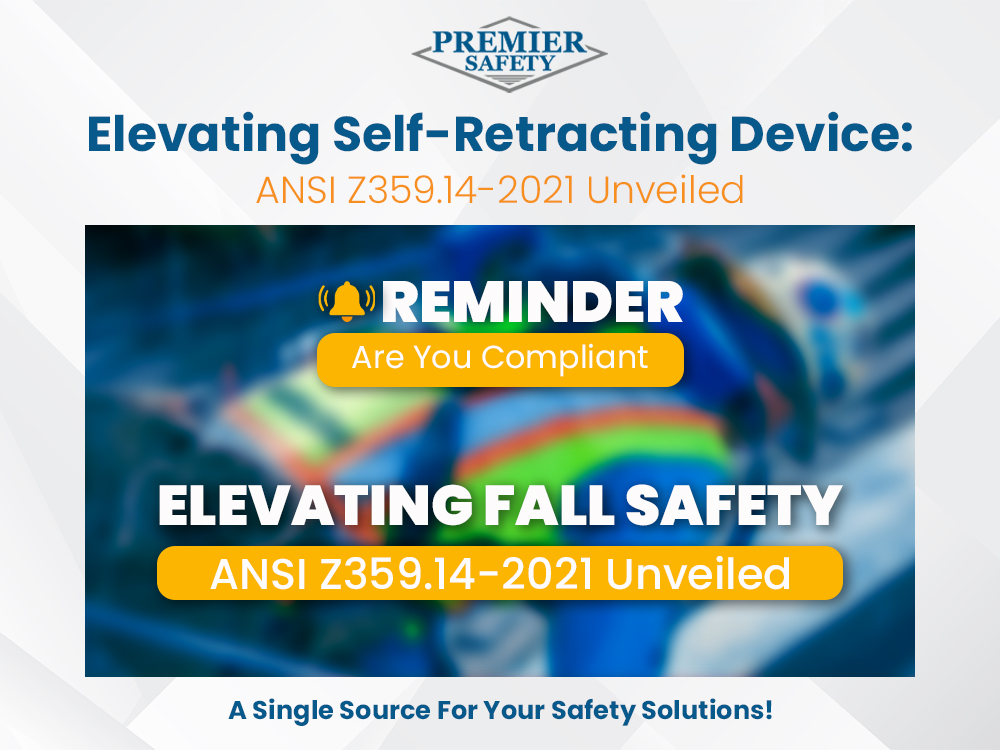Elevating Self-Retracting Device: ANSI Z359.14-2021 Unveiled
Posted by Michael Womack - Premier Safety on Sep 25th 2023

In the world of workplace safety, staying abreast of evolving standards is paramount. The American National Standards Institute (ANSI) has made a significant update with the release of ANSI Z359.14-2021.
This revised standard, that took effect on August 1, 2023, focuses on Safety Requirements for Self-Retracting Devices (SRDs) used in personal fall arrest and rescue systems. Let's explore the key changes introduced by ANSI Z359.14-2021 and what they mean for those working with SRDs.
Streamlined SRD Classification
One of the most noticeable changes is the simplification of SRD classification. In the 2014 version, we divided SRDs into types (SRL, SRL-R, SRL-LE) and classes (Class A or Class B). The 2021 revision aims to make this classification more user-friendly:
Types:
We now categorize SRDs as SRL, SRL-P, and SRL-R.
SRL stands for self-retracting lifeline. SRL-P is a personal use device that attaches to a full-body harness. SRL-R, on the other hand, has rescue/retrieval capabilities.
Classes:
Designate classes as Class 1 or Class 2, linking them to acceptable anchorage locations. Class 1 devices are for use at or above dorsal D-ring anchorage spots.
Users use Class 1 devices at or above dorsal D-ring anchorage spots. Users use Class 2 devices above, at, or up to 5 feet below the dorsal D-ring anchorage positions. Class 2 devices must have a leading edge rating.
This simplification makes it easier for workers and safety professionals to select the right SRD for their specific needs.
Enhanced Safety Factors
Safety is the foundation of fall protection. ANSI Z359.14-2021 places an emphasis on safety by increasing safety factors on various components and tests. These changes aim to reduce the risk of accidents and injuries when SRDs are in use, creating a safer working environment
Rigorous Testing Regime
The 2021 update introduces a comprehensive testing system for personal SRDs, also known as SRL-Ps. A person wears these devices on their safety harness. These tests guarantee maximum safety in fall-prone situations. They focus on specific issues that have led to recalls before.
Standardized Labeling:
Clear and standardized labeling is pivotal for informing users about a product's capabilities. ANSI Z359.14-2021 standardizes labels and markings, making it easier for users to identify compliant SRDs. These labels convey essential information about an SRD's capabilities, empowering workers, and safety experts to make informed choices.
Understanding the Types and Classes:
To gain a deeper understanding, let's delve into the revised types and classes:
Types:
SRLs are widely used and versatile. They stop falls and reduce impact forces on users when falling.
SRL-P is for personal use, attaching to a user's harness. They play a crucial role in personal fall arrest systems.
SRL-R is a lifelinethat can rescue and retrieve workers in emergencies when they fall, ensuring their safe return.
Classes:
Class 1 SRDs are versatile for various fall protection needs. You can use them at or above dorsal D-ring anchorage spots.
Class 2 SRDs have a design for using above, at, or up to 5 feet below dorsal D-ring anchor points. These devices are also leading edge rated, making them ideal for work environments with edge exposures.
Standardized SRD Overhead Performance Criteria:
A significant change in ANSI Z359.14-2021 is the introduction of standardized overhead performance criteria for all SRDs. This simplifies the selection process, ensuring workers can quickly identify the right device for their specific work conditions.
Revised Testing Requirements:
The 2021 revision significantly overhauled the testing requirements for SRDs. These changes affect how end-users use SRDs in the field, mainly impacting manufacturers and testing laboratories. Key changes include:
Compliance Timeline for Existing SRDs:
Understanding the compliance timeline is vital for organizations that mandate ANSI compliance. ANSI/ASSP Z359.14-2021 took effect on August 1, 2023. After this date, we will consider SRDs marked as compliant with previous revisions to be non-compliant.
To transition smoothly, organizations should plan ahead for using 2021-compliant devices and talk to manufacturers to ensure compliance.
Conclusion:
ANSI Z359.14-2021 marks a significant stride in the field of fall protection and workplace safety. These revisions simplify SRD classification, boost safety factors, introduce rigorous testing, standardize labeling, and emphasize safety across the board.
It’s crucial for stakeholders to prioritize safety by ensuring their fall protection equipment complies with the latest ANSI standards. This promise keeps workers safe and promotes a culture of safety, so everyone can go home safely after work.

